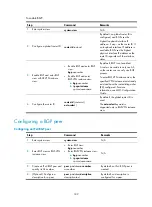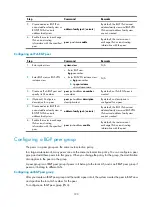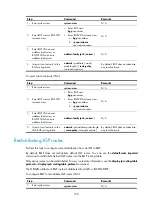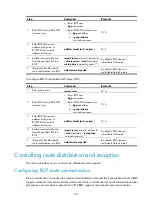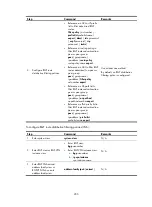
194
Step Command
Remarks
1.
Enter system view.
system-view
N/A
2.
Enter BGP view or BGP-VPN
instance view.
•
Enter BGP view:
bgp
as-number
•
Enter BGP-VPN instance view:
a.
bgp
as-number
b.
ip vpn-instance
vpn-instance-name
N/A
3.
Create an EBGP peer group.
group
group-name
external
By default, no EBGP peer group is
created.
4.
Create an IPv4 BGP peer and
specify its AS number.
peer
ip-address
as-number
as-number
By default, no IPv4 BGP peer is
created.
5.
Add the peer into the EBGP
peer group.
peer
ip-address
group
group-name
[
as-number
as-number
]
By default, no peer exists in the
peer group.
The
as-number
as-number
option,
if used, must specify the same AS
number as the
peer
ip-address
as-number
as-number
command.
6.
(Optional.) Configure a
description for a peer group.
peer
group-name
description
description-text
By default, no description is
configured for the peer group.
7.
Create and enter BGP IPv4
unicast address family view or
BGP-VPN IPv4 unicast
address family view.
address-family ipv4
[
unicast
]
By default, the BGP IPv4 unicast
address family view and BGP-VPN
IPv4 unicast address family view
are not created.
8.
Enable the router to exchange
IPv4 unicast routing
information with peers in the
specified peer group.
peer
group-name
enable
By default, the router cannot
exchange IPv4 unicast routing
information with the peers.
To configure an EBGP peer group by using Method 2 (IPv6):
Step Command
Remarks
1.
Enter system view.
system-view
N/A
2.
Enter BGP view or BGP-VPN
instance view.
•
Enter BGP view:
bgp
as-number
•
Enter BGP-VPN instance view:
a.
bgp
as-number
b.
ip vpn-instance
vpn-instance-name
N/A
3.
Create an EBGP peer group.
group
group-name
external
By default, no EBGP peer group is
created.
4.
Create an IPv6 BGP peer and
specify its AS number.
peer
ipv6-address
as-number
as-number
By default, no IPv6 BGP peer is
created.










